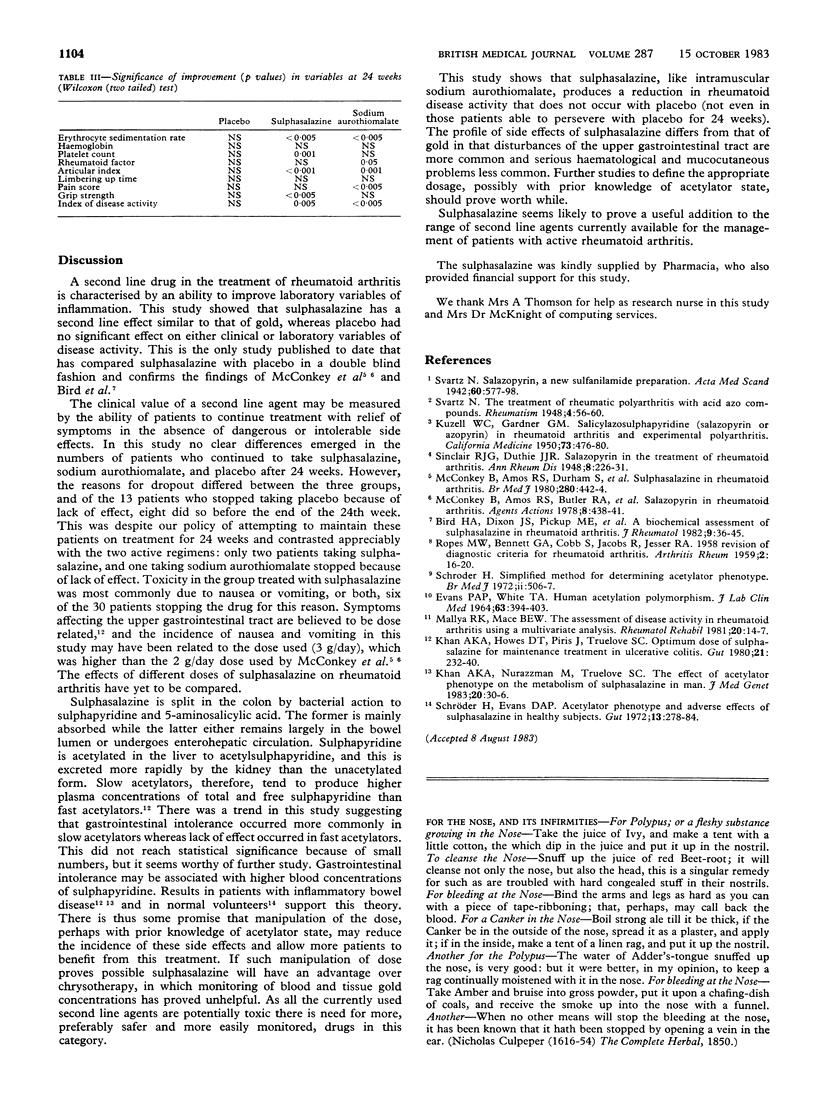Abstract
Uncontrolled studies have suggested that sulphasalazine may be an effective second line agent in rheumatoid arthritis. Sulphasalazine was therefore compared with placebo and intramuscular sodium aurothiomalate in 90 patients with active rheumatoid arthritis. After six months' treatment both sulphasalazine and sodium aurothiomalate had produced significant clinical and laboratory benefit, whereas placebo had produced no significant change in any variable. Thirteen patients stopped taking the placebo because of lack of effect whereas only two patients stopped taking sulphasalazine and one sodium aurothiomalate for this reason. The major toxicity encountered in the group treated with sulphasalazine was nausea or vomiting, or both; this may be related to slow acetylator phenotype. Sulphasalazine appears to be an effective second line agent, and further pharmacokinetic studies might prove useful in diminishing gastrointestinal side effects.
Full text
PDF


Selected References
These references are in PubMed. This may not be the complete list of references from this article.
- 1958 REVISION of diagnostic criteria for rheumatoid arthritis. Arthritis Rheum. 1959 Feb;2(1):16–20. doi: 10.1002/1529-0131(195902)2:1<16::aid-art1780020104>3.0.co;2-9. [DOI] [PubMed] [Google Scholar]
- Azad Khan A. K., Howes D. T., Piris J., Truelove S. C. Optimum dose of sulphasalazine for maintenance treatment in ulcerative colitis. Gut. 1980 Mar;21(3):232–240. doi: 10.1136/gut.21.3.232. [DOI] [PMC free article] [PubMed] [Google Scholar]
- Azad Khan A. K., Nurazzaman M., Truelove S. C. The effect of the acetylator phenotype on the metabolism of sulphasalazine in man. J Med Genet. 1983 Feb;20(1):30–36. doi: 10.1136/jmg.20.1.30. [DOI] [PMC free article] [PubMed] [Google Scholar]
- Bird H. A., Dixon J. S., Pickup M. E., Rhind V. M., Lowe J. R., Lee M. R., Wright V. A biochemical assessment of sulphasalazine in rheumatoid arthritis. J Rheumatol. 1982 Jan-Feb;9(1):36–45. [PubMed] [Google Scholar]
- EVANS D. A., WHITE T. A. HUMAN ACETYLATION POLYMORPHISM. J Lab Clin Med. 1964 Mar;63:394–403. [PubMed] [Google Scholar]
- KUZELL W. C., GARDNER G. M. Salicylazosulfapyridine (salazopyrin or azopyrin) in rheumatoid arthritis and experimental polyarthritis. Calif Med. 1950 Dec;73(6):476–480. [PMC free article] [PubMed] [Google Scholar]
- Mallya R. K., Mace B. E. The assessment of disease activity in rheumatoid arthritis using a multivariate analysis. Rheumatol Rehabil. 1981 Feb 1;20(1):14–17. doi: 10.1093/rheumatology/20.1.14. [DOI] [PubMed] [Google Scholar]
- McConkey B., Amos R. S., Butler E. P., Crockson R. A., Crockson A. P., Walsh L. Salazopyrin in rheumatoid arthritis. Agents Actions. 1978 Jun;8(4):438–441. doi: 10.1007/BF01968673. [DOI] [PubMed] [Google Scholar]
- McConkey B., Amos R. S., Durham S., Forster P. J., Hubball S., Walsh L. Sulphasalazine in rheumatoid arthritis. Br Med J. 1980 Feb 16;280(6212):442–444. doi: 10.1136/bmj.280.6212.442. [DOI] [PMC free article] [PubMed] [Google Scholar]
- Schröder H., Evans D. A. Acetylator phenotype and adverse effects of sulphasalazine in healthy subjects. Gut. 1972 Apr;13(4):278–284. doi: 10.1136/gut.13.4.278. [DOI] [PMC free article] [PubMed] [Google Scholar]
- Schröder H. Simplified method for determining acetylator phenotype. Br Med J. 1972 Aug 26;3(5825):506–507. doi: 10.1136/bmj.3.5825.506. [DOI] [PMC free article] [PubMed] [Google Scholar]
- Sinclair R. J., Duthie J. J. Salazopyrin in the Treatment of Rheumatoid Arthritis. Ann Rheum Dis. 1949 Sep;8(3):226–231. doi: 10.1136/ard.8.3.226. [DOI] [PMC free article] [PubMed] [Google Scholar]


